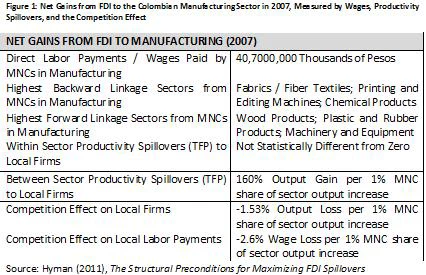The Pros and Cons of FDI
Empirical evidence over the last 15 years has not identified a universal net positive impact of FDI. When FDI is harnessed for good, benefits are:
· employment generation;
· technology transfer;
· backward and forward linkages;
· skill transfer and development;
· source of external finance;
· infrastructure development.
However, negative impacts of FDI have the potential to:
· repatriate profits;
· create path dependency.
The result can be volatile enclave economies with low linkages to the rest of the economy.
Shifting the paradigm
Archaic debates and cross-country growth regressions analyzing whether FDI does more good than harm might be the wrong approach overall. Unsurprisingly, academics and policymakers alike are increasingly researching better ways to attract FDI and the conditions under which FDI maximizes growth.
FDI under the sector lens in Colombia
Some recent analysis we have done in Colombia indicates that to really understand FDI it is best to take a sector specific lens.
The manufacturing sector in Colombia exemplifies this. As shown in figure 1 below, a policymaker might conclude that FDI in this sector:
· generates a moderate amount of employment
· has strong linkages to a few strategic sectors
· facilitates “backward” productivity spillovers (implying technology sharing with suppliers of multinational corporations) but not “horizontal” spillovers
· decreases revenues of competing firms in the same sector
The data thus show that FDI to manufacturing may be growth-conducive as it advances supplier sectors and creates jobs. Yet, FDI may not be an effective catalyst for boosting local manufacturing productivity.
Considering a different sector, FDI to the mining and mineral sector in Colombia results in low direct wages and generated employment, but spillovers to local mining firms are high.
Moving Forward
The Colombian example clearly shows that armed with firm and sector level data, policymakers can better determine how successful FDI targeting is at achieving growth objectives. Growth diagnostics can help to determine whether growth objectives should be to incentivize the development of sector clusters, facilitate technology transfers, or create jobs.
Using some simple empirical tools, policymakers can integrate FDI accordingly into competitiveness, industrial, and attraction policies—identifying its unique impact by sector.


Join the Conversation